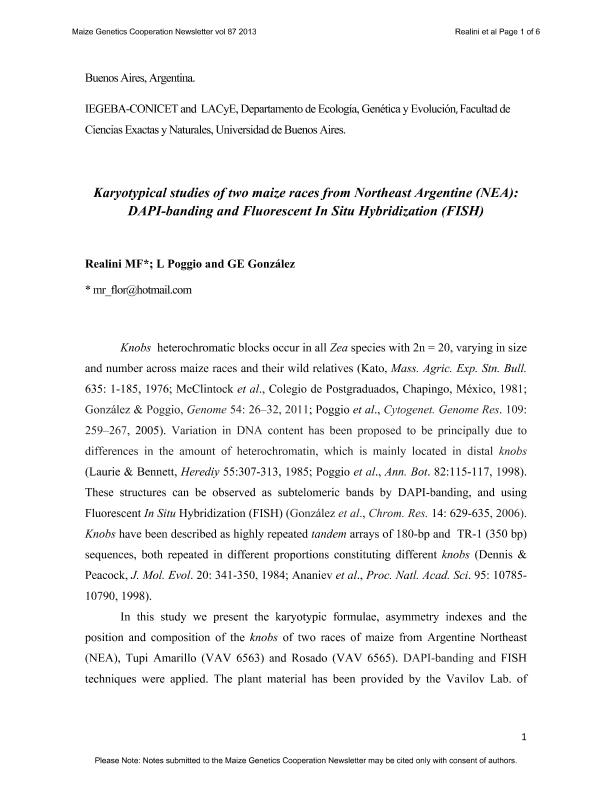Artículo
Karyotypical studies of two maize races from Northeast Argentine (NEA): DAPI-banding and Fluorescent In Situ Hybridization (FISH)
Fecha de publicación:
03/2013
Editorial:
University of Illinois
Revista:
Maize Genetics Cooperation Newsletter
ISSN:
1090-4573
Idioma:
Inglés
Tipo de recurso:
Artículo publicado
Clasificación temática:
Resumen
Knobs heterochromatic blocks occur in all Zea species with 2n = 20, varying in size and number across maize races and their wild relatives (Kato, Mass. Agric. Exp. Stn. Bull.635: 1-185, 1976; McClintock et al., Colegio de Postgraduados, Chapingo, México, 1981; González & Poggio, Genome 54: 26?32, 2011; Poggio et al., Cytogenet. Genome Res. 109: 259?267, 2005). Variation in DNA content has been proposed to be principally due to differences in the amount of heterochromatin, which is mainly located in distal knobs(Laurie & Bennett, Herediy 55:307-313, 1985; Poggio et al., Ann. Bot. 82:115-117, 1998). These structures can be observed as subtelomeric bands by DAPI-banding, and using Fluorescent In Situ Hybridization (FISH) (González et al., Chrom. Res. 14: 629-635, 2006). Knobs have been described as highly repeated tandem arrays of 180-bp and TR-1 (350 bp)sequences, both repeated in different proportions constituting different knobs (Dennis & Peacock, J. Mol. Evol. 20: 341-350, 1984; Ananiev et al., Proc. Natl. Acad. Sci. 95: 10785-10790, 1998). In this study we present the karyotypic formulae, asymmetry indexes and the position and composition of the knobs of two races of maize from Argentine Northeast(NEA), Tupi Amarillo (VAV 6563) and Rosado (VAV 6565). DAPI-banding and FISH techniques were applied. The plant material has been provided by the Vavilov Lab. of Universidad de Buenos Aires (UBA), and cultivated in the greenhouse of the Facultad deAgronomía, UBA.
Palabras clave:
Maize Races
,
Karyotypical Studies
,
Northeast Argentine
Archivos asociados
Licencia
Identificadores
Colecciones
Articulos(IEGEBA)
Articulos de INSTITUTO DE ECOLOGIA, GENETICA Y EVOLUCION DE BS. AS
Articulos de INSTITUTO DE ECOLOGIA, GENETICA Y EVOLUCION DE BS. AS
Articulos(OCA CIUDAD UNIVERSITARIA)
Articulos de OFICINA DE COORDINACION ADMINISTRATIVA CIUDAD UNIVERSITARIA
Articulos de OFICINA DE COORDINACION ADMINISTRATIVA CIUDAD UNIVERSITARIA
Citación
Realini, Maria Florencia; Poggio, Lidia; González, Graciela Esther; Karyotypical studies of two maize races from Northeast Argentine (NEA): DAPI-banding and Fluorescent In Situ Hybridization (FISH); University of Illinois; Maize Genetics Cooperation Newsletter; 87; 3-2013; 1-6
Compartir




